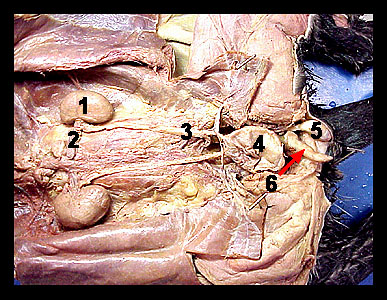|
|
|
|
||||||||||||||||||||||||||||||||||||||||||||||||||||||||||||||||||||||||||||||||||||||||||||||||||||||||||||||||||||||||||||||||||||||||||||||||||||
|
This dissection shows the urinary and reproductive systems of a male cat. Observe the two bean-shaped kidneys located on the dorsal wall on either side of the vertebral column. Each kidney is surrounded by fat, and the right kidney is higher in position than the left. The kidneys are not suspended from the body wall by mesenteries but are covered by the peritoneal lining. Since they are not technically in the abdominal cavity but separated from it by the peritoneum, they are termed retroperitoneal. Note the renal artery and renal vein located in the hilus region of the kidney that carry blood to and from the kidney. Lying in the connective tissue close to the abdominal aorta and just anterior and medial to each kidney are the small adrenal glands, which resemble small lymph nodes in the cat. Draining each kidney is a tube called the ureter, which carries urine to the urinary bladder. A tube called the urethra conducts urine from the neck of the bladder to the outside of the body. Begin your observations of the male reproductive system at the testis, an oval body lying in the posterior part of the scrotal pouch. The shiny covering around the testis is the tunica vaginalis. The comma-shaped epididymis (a long highly coiled tube that receives sperm from the testis) is closely applied to the surface of the testis. The ductus deferens (also called the vas deferens) leaves the tail of the epididymis and, in the company with the testicular vessels and nerves, enters the spermatic cord. As the spermatic cord enters the abdominal cavity, note that it contains the ductus deferens, blood vessels and nerves. The site of passage through the body wall is known as the inguinal canal. The ductus deferens of the opposite sides then converge and soon enter the urethra, which leads to the penis. Various accessory glands, which secrete the seminal fluid, are associated with the ends of the ductus deferens and adjacent part of the urethra. In the cat, a small prostate gland surrounds the point of entrance of the two ductus deferens and the adjacent urethra. At the caudal end of the pelvic canal, a pair of Cowper´s (bulbourethral) glands enter the urethral canal. Note that the male cat does not have a seminal vesicle as does the human male. |
|
